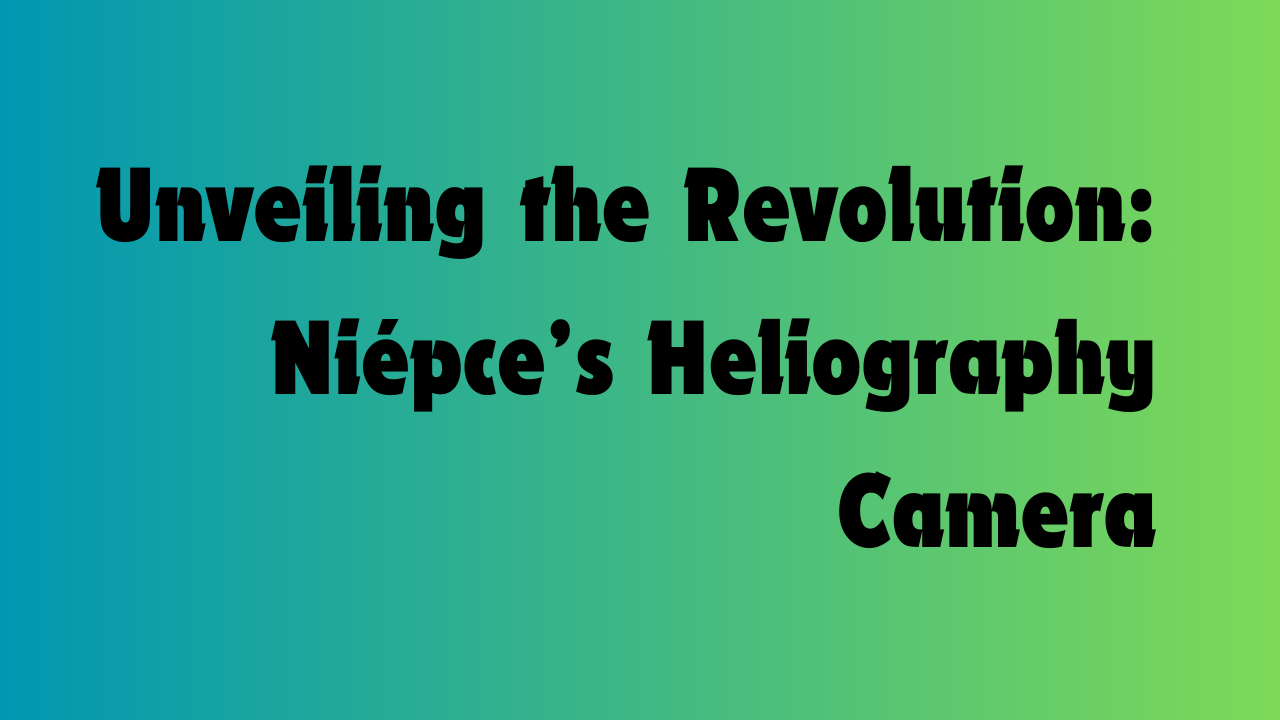SEO Meta Description: Discover the groundbreaking invention of Niépce’s Heliography Camera and its impact on photography. Unravel the history, mechanism, and significance of this innovative device.
Table of Contents
Introduction
In the vast tapestry of photographic history, one name stands as a beacon of innovation: Niépce. Renowned for his pioneering work in photography, Niépce introduced the world to the remarkable Heliography Camera, a device that revolutionized the way we capture and preserve moments in time. Join us on an exploration of this extraordinary invention, delving into its origins, mechanics, and enduring legacy.
Niépce’s Heliography Camera
The Birth of a Visionary Idea
Niépce’s journey began in the early 19th century, fueled by a relentless pursuit of capturing images through unconventional means. Amidst the backdrop of burgeoning technological advancements, he conceived the idea of utilizing light-sensitive materials to immortalize scenes onto surfaces—a concept that would lay the groundwork for the Heliography Camera.
From Concept to Reality: The Development Process
Translating his vision into reality was no small feat. Niépce dedicated years of meticulous experimentation, grappling with various materials and processes to refine his invention. Through a series of trial and error, he eventually achieved success, birthing the world’s first functional heliographic camera.
Mechanism Unveiled: How Niépce’s Heliography Camera Works
At the heart of Niépce’s invention lies a simple yet ingenious mechanism. The camera employs a combination of light-sensitive materials and optical components to capture images with astonishing clarity. When exposed to light, these materials undergo chemical reactions, imprinting the scene onto a receptive surface—a groundbreaking innovation that paved the way for modern photography.
Impact and Legacy: Revolutionizing the Art of Photography
Niépce’s Heliography Camera heralded a new era in photography, transcending the limitations of traditional methods. Its ability to faithfully reproduce scenes with unprecedented accuracy captivated the imaginations of artists and visionaries alike. From its humble beginnings, the heliographic process evolved into the foundation of modern photographic techniques, leaving an indelible mark on the world of visual arts.
Beyond Boundaries: Niépce’s Enduring Influence
The legacy of Niépce’s Heliography Camera extends far beyond its technological prowess. Its significance lies in its capacity to democratize photography, empowering individuals from all walks of life to capture and preserve their unique perspectives. In an age dominated by digital imagery, the spirit of Niépce’s invention continues to inspire creativity and innovation, reminding us of the transformative power of human ingenuity.
Exploring the Evolution: From Heliography to Digital Domains
While Niépce’s Heliography Camera laid the groundwork for photographic innovation, its journey did not end with the advent of digital technology. Instead, it serves as a testament to the enduring legacy of human creativity, adapting and evolving to meet the ever-changing demands of the modern world. Today, the principles pioneered by Niépce continue to shape the landscape of photography, bridging the gap between past and present.
Capturing Moments: Niépce’s Heliography Camera in Practice
To truly appreciate the impact of Niépce’s invention, one must experience it firsthand. Through the lens of a heliographic camera, moments frozen in time come to life, imbued with a sense of authenticity and nostalgia. Whether exploring landscapes or documenting everyday life, the Heliography Camera offers a unique perspective that transcends the confines of ordinary perception.
Embracing Innovation: The Future of Heliography
As technology continues to advance at an unprecedented pace, the future of heliography holds boundless potential. From enhanced imaging capabilities to novel applications in fields such as archaeology and conservation, the legacy of Niépce’s invention remains as vibrant and relevant as ever. With each new discovery and innovation, we pay homage to the pioneering spirit of those who dared to envision a world illuminated by the power of light.
Frequently Asked Questions (FAQs)
- How did Niépce’s Heliography Camera revolutionize photography? Niépce’s Heliography Camera revolutionized photography by introducing a groundbreaking method for capturing images with unprecedented clarity and precision. Through the use of light-sensitive materials and optical components, it paved the way for modern photographic techniques.
- What materials were used in Niépce’s Heliography Camera? Niépce utilized a variety of materials in his Heliography Camera, including light-sensitive chemicals and specialized lenses. These components worked in tandem to capture and preserve images onto receptive surfaces, marking a significant advancement in the field of photography.
- What impact did Niépce’s invention have on the art world? Niépce’s invention had a profound impact on the art world, democratizing photography and inspiring generations of artists and photographers. Its ability to faithfully reproduce scenes with unparalleled accuracy revolutionized the way we perceive and interact with visual imagery.
- How does Niépce’s Heliography Camera compare to modern photographic technology? While Niépce’s Heliography Camera laid the foundation for modern photographic technology, it differs significantly from contemporary methods in terms of efficiency and convenience. However, its enduring legacy continues to influence the development of cutting-edge imaging techniques.
- What role did Niépce play in the evolution of photography? Niépce played a pivotal role in the evolution of photography, pioneering innovative techniques that laid the groundwork for future advancements in the field. His relentless pursuit of capturing images through unconventional means inspired generations of photographers and innovators.
- How can I experience Niépce’s Heliography Camera firsthand? To experience Niépce’s Heliography Camera firsthand, one can explore museums and exhibitions showcasing early photographic equipment. Additionally, there are enthusiasts and collectors who specialize in recreating and using vintage photographic techniques, providing an immersive glimpse into the past.
Conclusion
In the annals of photographic history, few inventions have left as profound a mark as Niépce’s Heliography Camera. From its humble origins to its enduring legacy, this remarkable device continues to captivate the imaginations of artists and innovators worldwide. As we reflect on its significance, let us celebrate the ingenuity and vision of those who dared to defy convention and illuminate the world through the lens of innovation.




